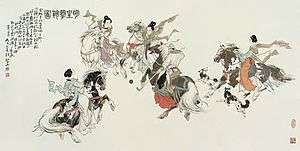Dakyu

Pinyin: 击鞠 Jījū; Hangul:격구 Gyekgu; Dakyu (打毬 Dakyū) is an equestrian sport, which was introduced from Persia, Chogan (Persian: چوگان ) via Tibet to China, Korea and Japan then took this name which means hitting ball. This game has also proliferated to the westward in another name, Polo.
History
Originally from Persia in the 6th century B.C.,[1] dakyu was popularly played during Tang Dynasty in China. Dakyu was also popular for the medieval Korea and Japan. In Korea, Chosun Dynasty adopted Gyekgu (Dakyu) as one of the compulsory subjects to recruit the military officers until 17th century. Japan as early as the Nara period. It remained popular amongst the aristocracy until the Kamakura period, when it gradually died out (the last recorded game being in 986).[2]
In the eighteenth century the game reappeared, largely due to support from Tokugawa Yoshimune. By this time it had evolved from a polo-like game (using mallets) to something more akin to lacrosse.[2] During this period, dakyu was considered a corollary to military training (training the skills needed to wield a spear from horseback).[3] This aspect was downplayed in the Meiji era, when the game again lost favour; today, it survives only as a cultural asset.[4]
Gameplay
Dakyu was played both on foot and on horseback, but the equestrian version was more popular among the aristocracy and was thus better documented. Rules vary, but two main forms survive to the present day. Both involve two teams of riders (designated by the colours red and white) attempting to project a number of balls into a goal. This goal, originally a hoop placed on the ground, is now more commonly a circular hole on a wall.[4]
Kagemiryu style
In Kagemiryu or Hachinohe style play, which dates from the eighteenth century, the teams are made up of four riders each. The players race to propel the 30 cm diameter balls of their colour into the four raised goals (two for each side), shooting from a preset distance of between 18 and 27 metres from the goal. A successful goal is signalled by percussion; drums for the white team, gongs for the red. The winning team is the first to get all of their balls into the goals.[4]
Yamagata style
In the Yamagata or Imperial style of play, shorter sticks (at only 1m, less than half the length of those used in the Hachinohe style) are used, and both teams shoot for a single goal. The ball is also smaller, being only a few centimetres in diameter. Five balls are used in Yamagata style games, and eleven in Imperial games. When one side has successfully got all of its balls into the goal, a final ball called the agemari is put into play - whichever team then scores with the agemari then wins the game.[4] This aspect of play has drawn comparisons with the game of billiards.[5]
References
- ↑ Nihon Yunesuko Kokunai Iinkai (1973). Japan; its land, people and culture. University of Tokyo Press. p. 592.
- 1 2 Mangan, J. A.; Hong, Fan (2003). Sport in Asian Society: Past and Present. Routledge. p. 396. ISBN 9780714653426.
- ↑ Turnbull, Stephen (2008). The Samurai Swordsman: Master of War. Tuttle publishing. p. 54. ISBN 9784805309568.
- 1 2 3 4 Guttmann, Allen; Thompson, Lee Austin (2001). Japanese Sports: A History. University of Hawaii Press. pp. 36–38. ISBN 9780824824648.
- ↑ Womack, Mari (2003). Sport As Symbol: Images of the Athlete in Art, Literature and Song. McFarland. p. 131. ISBN 9780786415793.